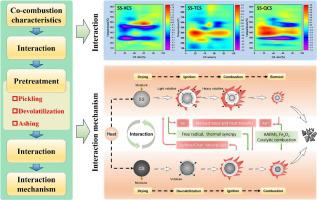当前位置:
X-MOL 学术
›
Sci. Total Environ.
›
论文详情
Our official English website, www.x-mol.net, welcomes your feedback! (Note: you will need to create a separate account there.)
Investigation on the interaction mechanism during co-combustion of sewage sludge and coal slime: The effect of coal slime type and pretreatment method
Science of the Total Environment ( IF 9.8 ) Pub Date : 2024-04-14 , DOI: 10.1016/j.scitotenv.2024.172419 Yanlin Wang , Li Jia , Baihe Guo , Jingkuan Li , Tao Bai , Zhiping Jin , Yan Jin
Science of the Total Environment ( IF 9.8 ) Pub Date : 2024-04-14 , DOI: 10.1016/j.scitotenv.2024.172419 Yanlin Wang , Li Jia , Baihe Guo , Jingkuan Li , Tao Bai , Zhiping Jin , Yan Jin

|
Co-combustion of sewage sludge (SS) and coal slime (CS) is the preferred method for mitigating their environmental impact and increasing their added value. However, the interaction mechanism between SS and CS during the co-combustion process has not yet developed a unified understanding. This work aims to obtain the effect of CS types on SS-CS co-combustion and reveal the interaction mechanism between SS and CS based on the influence of pretreatment methods on the interaction. The results showed that during co-combustion, SS reduced the ignition and burnout temperatures, and CS with high fixed carbon content (e.g., XCS) improved the comprehensive combustion characteristics. Principal component analysis showed that the effect of CS on co-combustion was more significant. The interaction between SS and CS mainly occurred within 100–700 °C, in which inhibition and synergism coexisted. The large differences in the interactions before and after de-volatilization and pickling treatments revealed that the volatiles and ash in SS were the main interaction factors. The analysis of the interaction mechanisms showed that the free radicals and heat released from the SS volatiles combustion accelerated the weight loss of CS, but the formation of tars from its incomplete combustion may inhibit the decomposition of CS. The interaction in the fixed carbon combustion stage was mainly caused by SS ash, which can catalyze the combustion of CS fixed carbon, but for the high ash CS (e.g., QCS), the combustion of fixed carbon was hindered by the addition of SS ash higher than 10 %. The final manifestation (synergy or inhibition) of SS and CS interactions was the result of the competitive balance of the above interactive behaviors. This work provides a more comprehensive understanding of the interaction between SS and CS during co-combustion.
中文翻译:

污泥与煤泥混燃相互作用机理研究:煤泥类型和预处理方法的影响
污水污泥(SS)和煤泥(CS)混烧是减轻其环境影响和增加其附加值的首选方法。然而,SS和CS在混烧过程中的相互作用机制尚未形成统一的认识。本工作旨在获得CS类型对SS-CS共燃的影响,并基于预处理方法对相互作用的影响揭示SS和CS之间的相互作用机制。结果表明,在混燃过程中,SS降低了着火温度和燃尽温度,高固定碳含量的CS(如XCS)改善了综合燃烧特性。主成分分析表明CS对混燃的影响更为显着。 SS与CS之间的相互作用主要发生在100~700℃范围内,抑制作用与协同作用并存。脱挥和酸洗处理前后相互作用的较大差异表明SS中的挥发分和灰分是主要的相互作用因素。相互作用机制分析表明,SS挥发物燃烧释放的自由基和热量加速了CS的失重,但不完全燃烧形成的焦油可能抑制CS的分解。固定碳燃烧阶段的相互作用主要是SS灰分引起的,SS灰分可以催化CS固定碳的燃烧,但对于高灰分CS(例如QCS),SS灰分的添加阻碍了固定碳的燃烧高于10%。 SS和CS交互的最终表现(协同或抑制)是上述交互行为竞争平衡的结果。这项工作提供了对共燃过程中 SS 和 CS 之间相互作用的更全面的了解。
更新日期:2024-04-14
中文翻译:

污泥与煤泥混燃相互作用机理研究:煤泥类型和预处理方法的影响
污水污泥(SS)和煤泥(CS)混烧是减轻其环境影响和增加其附加值的首选方法。然而,SS和CS在混烧过程中的相互作用机制尚未形成统一的认识。本工作旨在获得CS类型对SS-CS共燃的影响,并基于预处理方法对相互作用的影响揭示SS和CS之间的相互作用机制。结果表明,在混燃过程中,SS降低了着火温度和燃尽温度,高固定碳含量的CS(如XCS)改善了综合燃烧特性。主成分分析表明CS对混燃的影响更为显着。 SS与CS之间的相互作用主要发生在100~700℃范围内,抑制作用与协同作用并存。脱挥和酸洗处理前后相互作用的较大差异表明SS中的挥发分和灰分是主要的相互作用因素。相互作用机制分析表明,SS挥发物燃烧释放的自由基和热量加速了CS的失重,但不完全燃烧形成的焦油可能抑制CS的分解。固定碳燃烧阶段的相互作用主要是SS灰分引起的,SS灰分可以催化CS固定碳的燃烧,但对于高灰分CS(例如QCS),SS灰分的添加阻碍了固定碳的燃烧高于10%。 SS和CS交互的最终表现(协同或抑制)是上述交互行为竞争平衡的结果。这项工作提供了对共燃过程中 SS 和 CS 之间相互作用的更全面的了解。



























 京公网安备 11010802027423号
京公网安备 11010802027423号